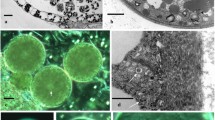Summary
An ultrastructural study of the development of the resting sporangium ofSynchytrium endobioticum (Schilb.) Perc. infecting potato cells is presented. The resting sporangium is found to have a single large, centrally placed nucleus with a prominent nucleolus through its entirein situ development. The cytoplasmic organization of the resting sporangium is further characterized by numerous membrane-bound lipid bodies and osmiophilic bodies. The latter have a characteristic sieve-like appearance, probably because certain storage components have been extracted during preparation for electron microscopy. Because of the similar location and appearance of these osmiophilic bodies it is suggested that they are identical to what has earlier (based on light microscopy) been described as chromatin granules; and the ultrastructural studies presented here show that “nucleolar discharge” which was described from light microscopic observations as leading to chromatin granules in the cytoplasm, and finally forming the nuclei of the zoospores (bally 1912,curtis 1921,percival 1910) simply does not occur.
The appearance of dense fibrillar-like structures on the sporangial surface at an early stage of resting sporangium development ultrastructurally distinguishes the resting sporangium from the zoosporangium. The development of the layered portion of the thick sporangial wall is shown to be due to the fusion of vacuoles containing pre-made wall fibrils with the cell membrane. It is suggested that the inner compact wall layer which is essentially substructureless is formed by the membrane itself.
The characteristic “wings” of the matureS. endobioticum resting sporangium originate from the potato host cell wall. Remnants of host cell organelles in the outermost layer of the resting sporangium wall show that degradation of the host cell cytoplasm contributes to wall formation of the parasite.
Similar content being viewed by others
References
Anderson, P. J., 1967: Purification and quantitation of glutaraldehyde and its effect on several enzyme activities in skeletal muscle. J. Histochem. Cytochem.15, 652–661.
Bally, W., 1912: Cytologische Studien an Chytridineen. Jahr. Wiss. Bot.50, 95–156.
Curtis, K. M., 1921: The life history and cytology ofSynchytrium endobioticum, the cause of wart disease in potato. Phil. Trans. Royal Soc. London, ser. B210, 409–478.
Heim, P., 1956: Remarques sur le développement, les divisions nucléaires et le cycle évolutif duSynchytrium endobioticum (Schilb.) Perc. Rev. de Mycol.21, 93–120.
Johnson, T., 1908: Potato black scab. Nature79, 67.
Karling, J. S., 1964:Synchytrium, 470 pp. New York-London: Academic Press.
Lange, L., Lange, B., Lange, M., 1978: Four imperfectly known diseases ofAnemone nemorosa. Bot. Tidsskr.73, 112–123.
—,Olson, L. W., 1981 a: Germination and parasitation of the resting sporangia ofSynchytrium endobioticum. Protoplasma106, 69–82.
— —, 1981 b: Development of the zoosporangia ofSynchytrium endobioticum, the causal agent of potato wart disease. Protoplasma106, 97–108.
Lingappa, B. T., 1958: The cytology of development and germination of resting sporesSynchytrium brownii. Amer. J. Bot.45, 613–620.
Mills, G. L., Cantino, E. C., 1975: The single microbody in the zoospore ofBlastocladiella emersonii is a “symphomicrobody”. Cell Differentiation4, 35–43.
Mygind, H., 1957: Kartoffelbrok, 58 pp. København: Statens Plantetilsyn.
Olson, L. W., Edén, U., 1977: A glass bead treatment facilitating the fixation and infiltration of yeast and other refractory cells for electron microscopy. Protoplasma91, 417–420.
— —,Lange, L., 1980: The endobiotic thallus ofPhysoderma maydis, the causal agent of Physoderma disease of maize. Protoplasma103, 1–16.
Percival, J., 1910: Potato “wart” disease: The life history and cytology ofSynchytrium endobioticum (Schilb.) Perc. Cbl. Bakt.2, 440–447.
Reynolds, E. S., 1963: The use of lead citrate at high pH as an electron opaque stain in electron microscopy. J. Cell Biol.17, 208–212.
Spieckermann, A., Kotthoff, P., 1924: Die Prüfung von Kartoffeln auf Krebsfestigkeit. Deutsche Landw. Pr.51, 114–115.
Spurr, A. R., 1969: A low viscosity epoxy resin embedding media for electron microscopy. J. Ultrastruct. Res.26, 31–43.
Author information
Authors and Affiliations
Rights and permissions
About this article
Cite this article
Lange, L., Olson, L.W. Development of the resting sporangia ofSynchytrium endobioticum, the causal agent of potato wart disease. Protoplasma 106, 83–95 (1981). https://doi.org/10.1007/BF02115963
Received:
Accepted:
Issue Date:
DOI: https://doi.org/10.1007/BF02115963



